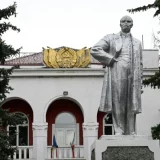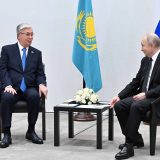09/10-16/2022: Worrying resumption of military tensions between Azerbaijan and Armenia, the most serious since the November 2020 ceasefire: an official death toll of 206.
Despite the release of 5 Armenian prisoners by Azerbaijan on September 8, following the fourth meeting on August 31 in Brussels between the leaders of Azerbaijan, Armenia and the European Council, heavy fighting resumed on September 10 in Karabakh and the Armenian-Azerbaijani border.
Between September 10 and 12, the Azerbaijani side denounced a dozen ceasefire violations by “units of the Armenian armed forces” and by “members of illegal Armenian detachments” who allegedly engaged in firing in direction of the settlement of Zaylik of the Kelbajar region, then of the settlements of Zaylik, Yellija, Yukhari Ayrim in the Kelbajar region, and of the settlement of Sadinlar in the Lachin region, then the next day of the settlement of Novoivanovka in the Gadabay region and Husulu settlement in Lachin region. On September 13, the Azerbaijani Defence Minister further asserted that “Armenian army commando groups [had] mined the areas and resupplied the roads between the positions of the Azerbaijani army units in different directions, in using the mountainous terrain of these areas […] in darkness” and that “in order to prevent the provocation of the Armenian armed forces and military threats against the territory and sovereignty of our country, as well as to ensure the security of our military personnel, including civilian workers involved in infrastructure works in the Kalbajar territory and Lachin districts, decisive retaliatory measures [were] taken by the Azerbaijani army units deployed in these direction”. He also claimed: “Overall, the provocations of the Armenian Armed Forces towards the districts of Lachin, Gadabey, Dashkasan and Kalbajar on the state border, and the firing at the positions of the Azerbaijani army in these regions with various types of weapons, have been intensive and systematic over the past month. At the same time, Armenia carried out a concentration of offensive weapons, heavy artillery and personnel along the borders of Azerbaijan. All these facts once again indicated that Armenia was preparing for a full-scale military provocation. With such actions, Armenia also aims to slow down the implementation of the large-scale civil infrastructure projects implemented by Azerbaijan in the border regions liberated from occupation and to maintain an atmosphere of tension near the borders of Azerbaijan”.
These statements were denied by the Armenian side. On September 12, while the extraordinary ambassador of Armenia, Edmond Maroukian denounced the fact that “when Azerbaijan plans another provocation on the border, it organizes a false base in the information space aimed at legitimizing this provocation before carrying it out”, the “mediator of Nagorno-Karabakh”, Gegham Stepanian, denounced the targeting of three houses by the Azerbaijani side in the villages of Karmir Shuka and Taghavard in the province of Martouni, which was denied by the Azerbaijani side. On September 13, the Armenian side denounced, for its part, the use of “artillery, mortars, drones and large-caliber guns in the directions of Vardenis, Sotk, Artanish, Ishkhanasar, Goris and Kapan, targeting both military and civilian infrastructure”.
On September 9 and 10, the new United States representative within the Minsk group and principal adviser of the United States for the negotiations with the Caucasus, Philip Reeker successively met the Armenian Minister of Foreign Affairs, Ararat Mirzoyan, then the Prime Armenian Minister, Nikol Pashinian, and Deputy Speaker of the National Assembly and special envoy for the normalization of relations between Armenia and Turkey, Ruben Rubinian. Nikol Pashinian reaffirmed the “need to restore the negotiation process within the Minsk Group co-chairmanship”. On September 12, Nikol Pashinyan chaired a meeting of the Security Council, which resulted in the decision “to formally request the Russian Federation to implement the provisions of the Treaty of Friendship, Cooperation and Mutual Cooperation of the ‘Collective Security Treaty Organization and [to appeal] to the UN Security Council regarding the aggression against the sovereign territory of the Republic of Armenia”, before talking by telephone with the Russian, French presidents , US and Iranian, as well as that of the European Council.
On September 13, Nikol Pashinian announced before the National Assembly the death of 49 soldiers in the clashes while being offensive by declaring: “one of the principles proposed by Azerbaijan was the recognition of the territorial integrity of the ‘other. There is a need for clarification here. What is meant by territorial integrity? Does Azerbaijan also designate the territories of Armenia that were occupied by Azerbaijan following the events of May 2021 […]” without further details. The Ministry of Health announced 3 civilian casualties. On the Azerbaijani side, the Ministry of Defence announced the death of 50 Azerbaijani soldiers, buried the same evening in the Alley of the Martyrs in Baku.
On the same day, the US State Department called for an “immediate cessation of hostilities” as did Toivo Klaar, European Union Special Representative for the South Caucasus, Josep Borell, EU High Representative for Foreign Affairs and Security Policy, OSCE officials, or the United Nations General Secretariat. While the Elysée announced that “France would bring the situation to the United Nations Security Council, of which it currently holds the presidency“, the CSTO declared that “the use of force [was] unacceptable [and that] only the political and diplomatic means as well as the agreements enshrined in the declarations of the leaders of Azerbaijan, Armenia and Russia of November 09, 2020, January 11, 2021 and November 26, 2021 should be used to resolve contradictions”. The Georgian Prime Minister said he was ready for mediation during his telephone conversation with his Armenian counterpart.
A meeting of the CSTO Security Council convened on the same day which Nikol Pashinyan described as “satisfactory” with an “open and honest exchange of views” and during which he called for the military intervention of the CSTO to “restore the territorial integrity of Armenia“. A first ceasefire under the aegis of Russia was not respected on September 13.
On September 14, Nikol Pashinian answered questions before the National Assembly after announcing the figure of 105 Armenian soldiers who had died since September 12 and he declared on this occasion that he refused for the moment the establishment of martial law while stating: “Azerbaijan says: let’s recognize each other’s territorial integrity. We say that we agree and that we are ready to do so today. But the territories they occupied are within the territorial integrity of which state? If Azerbaijan claims that it is its territory, then we do not recognize the territorial integrity of Azerbaijan, because these are our territories, it is not a disputed territory, and in doing so Azerbaijan does not does not recognize our territorial integrity. […] As I said, I took responsibility for making difficult decisions in the name of peace. But difficult decisions do not mean decisions contrary to the interests of the state of the Republic of Armenia. We cannot sign a document called “Peace Treaty”, after which a new war will start in six months. We are ready to sign a document, as a result of which many will shout at us, call us traitors, the people may even decide to remove us from power, but as a result of which Armenia will receive lasting peace. We will be happy and grateful if, as a result of this, Armenia enjoys lasting peace and security in an area of 29,800 square kilometers. If it is provided to us, I will sign this decision. I am not interested in what will happen to me later, I am interested in what will happen to the Republic of Armenia later”.
A new ceasefire was decided on September 14, taking effect at 8 p.m.
Following a meeting of the Armenian Security Council on September 15 to which the “President of Nagorno Karabakh” Arayik Haroutiounian was invited, the latter declared: “no document relating to the status of Artsakh is under discussion in this stage. In my speech to the Armenian colleagues, I expressed all our concerns, emphasizing that no document can be above the right and aspirations of our people to live freely and in sovereignty. The Armenian authorities reaffirmed that no document relating to Artsakh will be signed without having discussed it with the authorities of Artsakh and taking into account the opinion of our people”, while 4000 people gathered in the streets of Stepanakert.
On the same day, the Azerbaijani Defence Ministry announced a death toll of 71 servicemen while the Deputy Minister of Territorial Administration of Armenia and Infrastructures, Vache Terterian, announced a death toll of 192 houses. residential buildings damaged in the provinces of Gegharkunik, Siounik and Vayots Dzor, 60 of which were completely destroyed, and the mediator of the Republic mentioned the displacement of 2,750 inhabitants of these regions.
On September 15, a CSTO delegation led by Anatoly Sidorov, its Joint Chiefs of Staff, who met with Defence Minister Suren Papikian, following which the CSTO claimed that this group is ” responsible for drawing up proposals for de-escalating tensions” and that its mission is to carry out “steps aimed at studying and monitoring the current situation in certain border areas“. The following day, September 16, Nikol Pashinian reported a death toll of 135 on the Armenian side.







